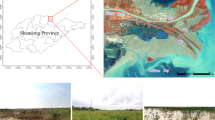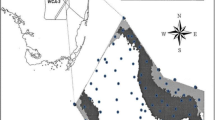Abstract
This study examined the uptake and effects of copper (Cu) from flooded agricultural soils to epibenthic amphipods (Hyalella azteca) using 10-day sediment toxicity tests. Soils were collected from 10 citrus agricultural sites in South Florida. One sediment toxicity test was conducted with one flooding of the 10 soils, and based on the results of this test a second sediment toxicity test was conducted with 4 of the soils, after four 14-day flooding and four 14-day drying intervals over 4 months. Sediment toxicity tests were conducted under flow-through conditions using U.S. EPA methodology. Effects on survival, dry weight, and whole-body Cu concentrations of H. azteca were determined. Cu concentrations in overlying water and sediment of both sediment toxicity tests exceeded regulatory criteria for aquatic organisms. Although survival of H. azteca was not consistently affected from the first to the second sediment toxicity tests, dry weight was consistently reduced and related to Cu concentrations in soil, overlying water, and pore water. Furthermore, whole-body tissue Cu concentrations were significantly higher in H. azteca in all 10 soil-water treatments in the first sediment toxicity test and in all 4 soil-water treatments in the second sediment toxicity test compared to controls. Whole-body tissue concentrations and effects on dry weight were related to Cu exposures in soil, overlying water, and pore water. In these managed soil-water systems, small fish consuming H. azteca with high concentrations of Cu may be at risk.

Similar content being viewed by others
References
Ahern MD, Morris S (1998) Accumulation of lead and its effects on Na+ balance in the freshwater crayfish Cherax destructor. J Exp Zool 281:270–279. doi:10.1002/(SICI)1097-010X(19980701)281:4<270::AID-JEZ3>3.0.CO;2-L
Ankley GT (1991) Predicting the toxicity of bulk sediments to aquatic organisms with aqueous test fractions: pore water vs. elutriate. Environ Toxicol Chem 10:1359–1366. doi:10.1897/1552-8618(1991)10[1359:PTTOBS]2.0.CO;2
Arnold WR (2005) Effects of dissolved organic carbon on copper toxicity: implications for saltwater copper criteria. Integr Environ Assess Manage 1:34–39. doi:10.1897/IEAM_2004a-002b.1
Borgmann U, Norwood WP (1997) Toxicity and accumulation of zinc and copper in Hyalella azteca exposed to metal-spiked sediments. Can J Fish Aquat Sci 54:1046–1054. doi:10.1139/cjfas-54-5-1046
Burton GA Jr (1992) Sediment toxicity testing. Lewis, Chelsea, MI
Call DJ, Polkinghorne CN, Markee TP, Brooke LT, Geiger DL, Gorsuch JW, Robillard KA (2006) Toxicity of silver in water and sediment to the freshwater amphipod Hyalella azteca. Environ Toxicol Chem 25:1802–1808. doi:10.1897/05-319R.1
DiToro DM, Allen HE, Bergman HL, Meyer JS, Paquin PR, Santore RC (2001) Biotic ligand model of the acute toxicity of metals 1 Technical basis. Environ Toxicol Chem 20:2383–2396. doi:10.1897/1551-5028(2001)020<2383:BLMOTA>2.0.CO;2
EvergladesNational Park (2001) Everglades National Park Strategic Plan 2001–2005. National Parks Service. U.S. Department of the Interior, Homestead, FL, pp 1–39
Finlayson B, Fujimura R, Huang ZZ (2000) Toxicity of metal-contaminated sediments from Keswick reservoir, California, USA. Environ Toxicol Chem 19:485–494. doi:10.1897/1551-5028(2000)019<0485:TOMCSF>2.3.CO;2
Florida Department of Environmental Protection (2003) Development and evaluation of numerical sediment quality assessment guidelines for Florida inland waters. Technical Report. FDEP, Tallahassee, FL
Frakes RA, Bargar TA, Bougher EA (2008) Sediment copper bioavailability to freshwater snails in South Florida: risk implications for the Everglades snail kite (Rostrhamus sociabilis plumbeus). Ecotoxicology 17:598–604
Green AS, Thomas CG, Blood ER (1993) Aqueous-, pore-water-, and sediment-phase cadmium: toxicity relationships for a meiobenthic copepod. Environ Toxicol Chem 12:1497–1506. doi:10.1897/1552-8618(1993)12[1497:APASCT]2.0.CO;2
Grosell M, Wood CM (2002) Copper uptake across rainbow trout gills: mechanisms of apical entry. J Exp Biol 205:1179–1188
Hall LW Jr, Anderson RD, Lewis BL, Arnold WR (2008) The influence of salinity and dissolved organic carbon on the toxicity of copper to the estuarine copepod, Eurytemora affinis. Arch Environ Contam Toxicol 54:44–56. doi:10.1007/s00244-007-9010-8
He ZL, Zhang MK, Yang XE, Stoffella PJ (2006) Release behavior of copper and zinc from sandy soils. Soil Sci Soc Am J 70:1699–1707. doi:10.2136/sssaj2005.0255
Hoang TC, Rogevich EC, Rand GM, Gardinali PR, Frakes AF, Bargar TA (2008a) Copper desorption in flooded agricultural soils and toxicity to the Florida apple snail (Pomacea paludosa): Implications in Everglades restoration. Environ Pollut 154:338–347. doi:10.1016/j.envpol.2007.09.024
Hoang TC, Rogevich EC, Rand GM (2008b) Copper uptake and depuration by juvenile and adult Florida apple snails (Pomacea paludosa). Ecotoxicology 17:605–615
Hoang TC, Schuler LJ, Rogevich EC, Bachman PM, Rand GM, Frakes RA (2008c) Copper release, speciation, and toxicity following multiple floodings of agriculture soils: implications in Everglades restoration. J Water Air Soil Pollut. doi:10.1007/s11270-008-9861-2
Ingersoll CG, Brumbaugh WG, Dwyer FJ, Kemble NE (1994) Bioaccumulation of metals by Hyalella azteca exposed to contaminated sediments from the upper Clark Fork River, Montana. Environ Toxicol Chem 13:2013–2020. doi:10.1897/1552-8618(1994)13[2013:BAOMBH]2.0.CO;2
Ingersoll CG, Ankley GT, Benoit DA, Brunson EL, Burton GA, Dwyer FJ, Hoke RA, Landrum PF, Norberg-King TJ, Winger PV (1995) Toxicity and bioaccumulation of sediment-associated contaminants using freshwater invertebrates: a review of methods and applications. Environ Toxicol Chem 14:1885–1894. doi:10.1897/1552-8618(1995)14[1885:TABOSC]2.0.CO;2
Ingersoll CG, Ivey CD, Brunson EL, Hardesty DK, Kemble NE (2000) Evaluation of toxicity: whole-sediment versus overlying-water exposures with amphipod Hyalella azteca. Environ Toxicol Chem 19:2906–1910. doi:10.1897/1551-5028(2000)019<2906:EOTWSV>2.0.CO;2
Iyengar GV, Venkatesh II, Subramanian KS, Woittiez JRW (1997) Analysis of biological samples: principles and practice. CRC Press, New York, 255 pp
Kemble NE, Brumbaugh WG, Brunson EL, Dwyer FJ, Ingersoll CG, Monda DP, Woodward DF (1994) Toxicity of metal-contaminated sediments from the upper Clark Fork River, Montana, to aquatic invertebrates and fish in laboratory exposures. Environ Toxicol Chem 13:1985–1997. doi:10.1897/1552-8618(1994)13[1985:TOMSFT]2.0.CO;2
Kemble NE, Dwyer FJ, Ingersoll CG, Dawson TD, Norberg-King TJ (1999) Tolerance of freshwater test organisms to formulated sediments for use as control materials in whole-sediment toxicity tests. Environ Toxicol Chem 18:222–230. doi:10.1897/1551-5028(1999)018<0222:TOFTOT>2.3.CO;2
Li J, Quabius ES, Wendelaar Bomga SE, Filk G, Lock RAC (1998) Effects of water-borne copper on branchial chloride cells and Na+/K+-ATPase activities in Mozambique tilapia (Oreochromis mossambicus). Aquat Toxicol 43:1–11. doi:10.1016/S0166-445X(98)00047-2
Mahony JD, DiToro DM, Gonzalez AM, Curto M, Dilg M, De Rosa LD, Sparrow LA (1996) Partitioning of metals to sediment organic carbon. Environ Toxicol Chem 15:2187–2197. doi:10.1897/1551-5028(1996)015<2187:POMTSO>2.3.CO;2
Milani D, Reynoldson TB, Borgmann U, Kolasa J (2003) The relative sensitivity of four benthic invertebrates to metals in spiked-sediment exposures and application to contaminated field sediment. Environ Toxicol Chem 22:845–854. doi:10.1897/1551-5028(2003)022<0845:TRSOFB>2.0.CO;2
Morgan JI, Henry RP, Wood CM (1997) The mechanism of acute silver nitrate toxicity in freshwater rainbow trout (Oncorhynchus mykiss) is inhibition of gill Na+ and Cl− transport. Aquat Toxicol 38:145–163. doi:10.1016/S0166-445X(96)00835-1
Morris JM, Collyard SA, Meyer JS (2003) Effects of chronic exposure on the nutritional composition of Hyalella azteca. Aquat Toxicol 63:197–206. doi:10.1016/S0166-445X(02)00177-7
Neumann PTM, Borgmann U, Norwood W (1999) Effect of gut clearance on metal body concentrations in Hyalella azteca. Environ Toxicol Chem 18:976–984. doi:10.1897/1551-5028(1999)018<0976:EOGCOM>2.3.CO;2
Norwood WP, Borgmann U, Dixon DG (2007) Interactive effects of metals in mixtures on bioaccumulation in the amphipod Hyalella azteca. Aquat Toxicol 84:255–267. doi:10.1016/j.aquatox.2007.02.023
Pennack RW (1989) Freshwater invertebrates of the United States. Wiley-Interscience, New York
Rand GM, Wheat JV, Carriger JF, Lee TA (2003) An automated overlying water renewal system for sediment toxicity. Environ Pollut 122:169–175. doi:10.1016/S0269-7491(02)00300-7
Rausch N, Ukonmaanaho L, Nieminen TM, Krachler M, Le Roux G, Shotyk W (2006) Evaluation of samplers and filter materials for the establishment of trace metal concentration profiles in peat bog porewaters using inductively coupled plasma-mass spectrometry. Anal Chim Acta 558:201–210. doi:10.1016/j.aca.2005.11.037
Shuhaimi-Othman M, Pascoe D (2002) Reduced Recruitment in Hyalella azteca (Saussure, 1858) exposed to copper. Ecotoxicol Environ Saf 53:59–64. doi:10.1006/eesa.2002.2174
Shuhaimi-Othman M, Pascoe D (2007) Bioconcentration and depuration of copper, cadmium, and zinc mixtures by the freshwater amphipod Hyalella azteca. Ecotoxicol Environ Saf 66:29–35. doi:10.1016/j.ecoenv.2006.03.003
Tomasovic MJ, Dwyer FJ, Green IV, Ingersoll CG (1995) Recovery of known-age Hyalella azteca (amphipoda) from sediment toxicity tests. Environ Toxicol Chem 14:1177–1180. doi:10.1897/1552-8618(1995)14[1177:ROKHAA]2.0.CO;2
U.S. Department of Agriculture (2005) Agricultural chemical usage summary. Fruit summary. National Agricultural Statistical Service. USDA, Washington, DC
U.S. EPA (2000) Methods for measuring the toxicity and bioaccumulation of sediment-associated contaminants with freshwater invertebrates, EPA/600/R-99/064, 2nd edn. U.S. Environmental Protection Agency, Washington DC
U.S. EPA (2003) Draft update of ambient water quality criteria for copper, EPA 822-R-03-026. Office of Water, Office of Science and Technology, U.S. Environmental Protection Agency, Washington, DC
Zahner HM, Van genderen EJ, Tomasso JR, Klaine SJ (2006) Whole-body sodium concentration in larval fathead minnows (Pimephales promelas) during and following copper exposure. Environ Toxicol Chem 25:1635–1639. doi:10.1897/05-543R.1
Acknowledgments
We thank Kathy Moore (Clemson University) for her help with chemical analysis. This is SERC contribution no. 406.
Author information
Authors and Affiliations
Corresponding author
Rights and permissions
About this article
Cite this article
Hoang, T.C., Schuler, L.J. & Rand, G.M. Effects of Copper in Flooded Florida Agricultural Soils on Hyalella azteca . Arch Environ Contam Toxicol 56, 459–467 (2009). https://doi.org/10.1007/s00244-008-9243-1
Received:
Accepted:
Published:
Issue Date:
DOI: https://doi.org/10.1007/s00244-008-9243-1




